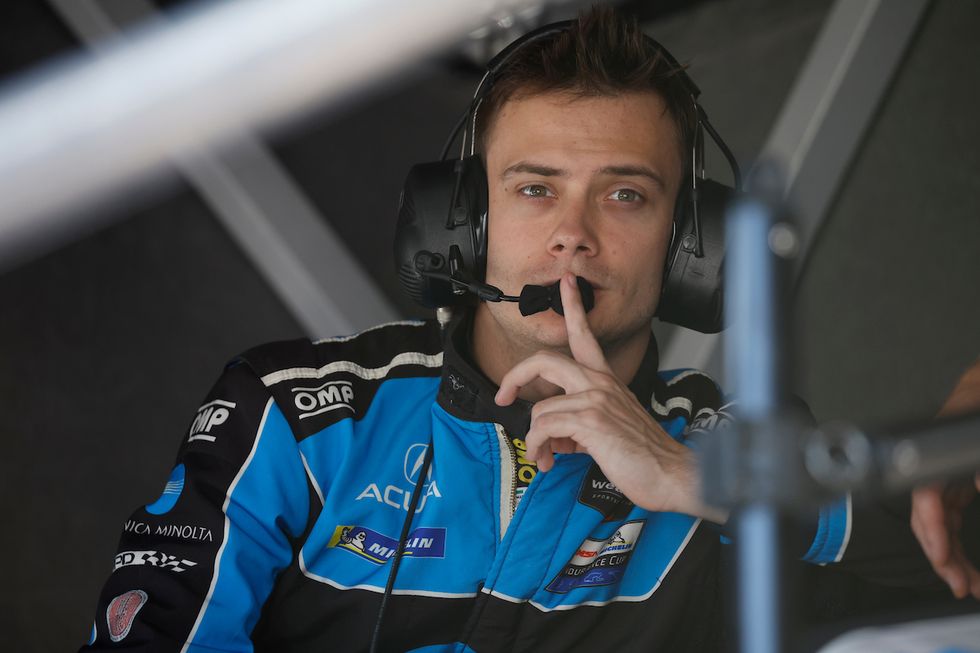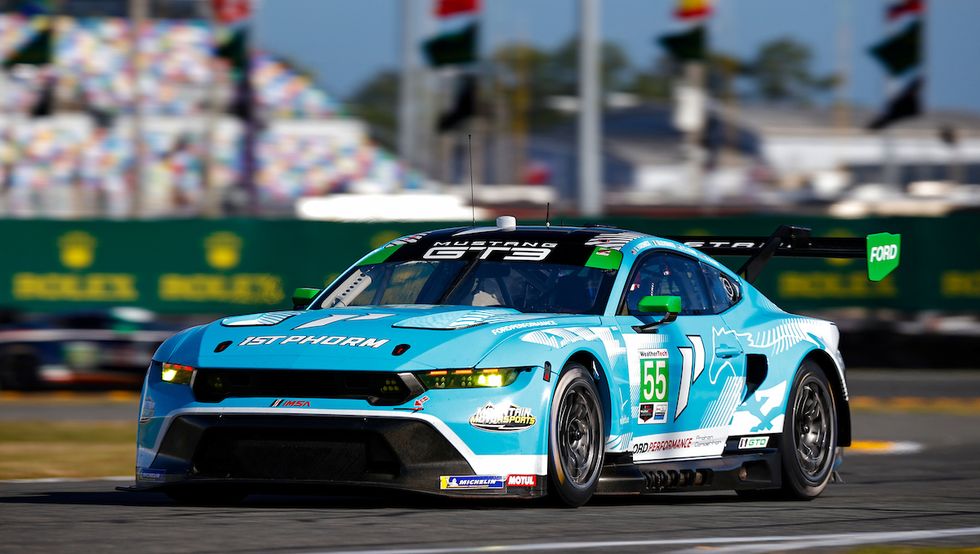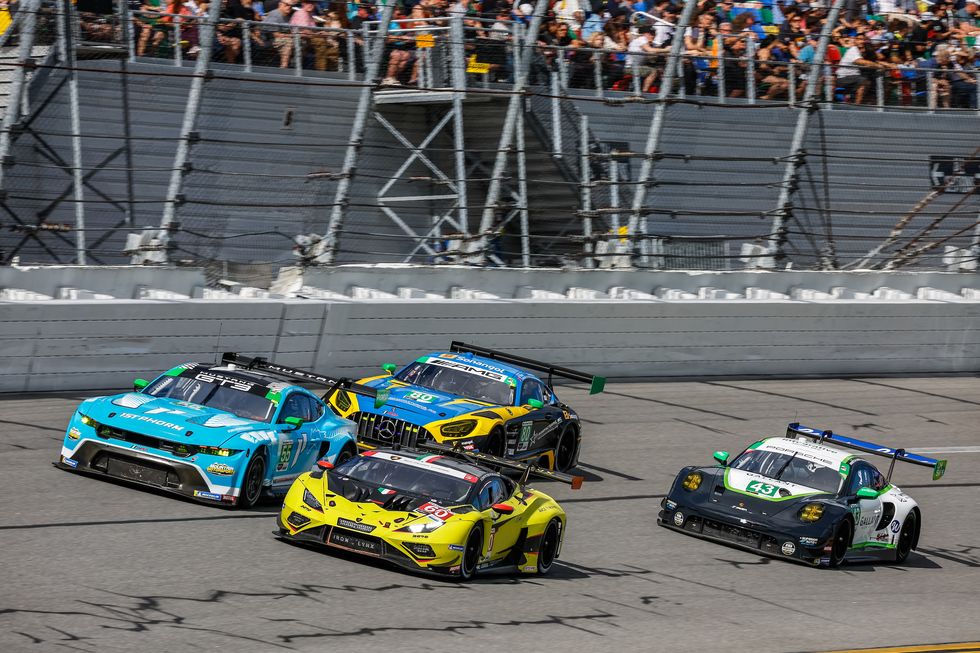- The close finish at this year’s Rolex 24 at Daytona, won by the Porsche Penske Motorsport No. 7 by 2.112 seconds, lived up to the race’s tradition.
- Building on that momentum for the rest of the IMSA WeatherTech SportsCar Championship season is the next hurdle for the series.
- Here’s five areas of emphasis we’d like to see IMSA consider as the series moves forward in 2024.
Is this going to be a breakout year for IMSA?
Judging by the success of the season-opening Rolex 24 at Daytona, where the combination of cars and drivers brought an impressive crowd to the France family’s Speedway by the Sea, it could be a big year for the WeatherTech Championship.
The close finish, won by the Porsche Penske Motorsport No. 7 by 2.112 seconds, lived up to the race’s tradition. Winners Felipe Nasr, Dane Cameron, Matt Campbell and Josef Newgarden benefitted from their crew’s final quick pit stop, which gained the decisive track position against the runner-up Cadillac of Action Express driven by Pipo Derani, Jack Aitken and Tom Blomqvist.
Here’s a checklist, call it a wishlist if you will, of how the momentum can continue for professional sports car racing in the U.S.:
Win at Le Mans
Traditionally, the Sebring 12-hour is the focus of the WeatherTech Championship after Daytona. But give a nod to the next 24-hour on the schedule in Le Mans. If an LMDh car run by an American team and IMSA regulars wins the great French race, IMSA will be on top of the world. That will be doubly true if the Penske team repeats its Daytona victory in France.
What are the chances? Last year in France, it appeared that a late BOP change to all Hypercars by the World Endurance Championship and the Automobile Club de l’Ouest resulted in just enough confusion at Toyota to open the door for Ferrari’s vaunted 499P to take an historic—and popular—victory. Finishing third was the Cadillac V-Series.R of Chip Ganassi Racing.
It remains to be seen how well performance is balanced this year between the generic LMDh platforms created by IMSA and the Hypercars that race in the WEC, a class where manufacturers have spent millions to build proprietary prototypes.
One could argue that the Rolex 24 might have been fixed when it came to BOP—judging by the excessive weight assigned to Acura, the brand that won last year’s race after the Meyer Shank Racing team bypassed the rulebook on tire pressures. Officials are only human and one wonders if last year’s result “weighed” on their minds. In any event, the Acura of WTRAndretti did not have the pace to catch the two leaders at the finish and was 15 seconds behind after the final restart.
On the other hand, Porsche Penske Motorsport took a new approach to getting the most out of its Porsche 963s. The Penske effort showed in the race, particularly at the finish when Nasr was under pressure from Blomqvist, when it came to braking and tire wear.
If the BOP is really balanced, it does come down to execution. Should the Penske team carry Porsche back to victory at Le Mans by better execution, imagine the groundswell of ticket sales to fans who want to see the team and its cars that won at Daytona and Le Mans.
Drivers, Tell Us What You Really Think
Remember the days of Holbert, Wollek, Bell, Brabham and Fangio? These stars of the original GTP category in the 1980s and 1990s leveraged the class beyond its obvious technical appeal. Not only did they win, these star drivers were interesting when they won—and sometimes more so when they lost.
Given the meager commitment by IndyCar to hybrid racing and its total absence in NASCAR, one could argue that the current GTP hybrids are the most compelling circuit racing machines in America. But what about the drivers?
Maybe it’s just me, but the comments by the IndyCar and Formula 1 drivers during the Rolex 24 were often more interesting than those of the IMSA regulars. Four-time Indy 500 winner Helio Castroneves was not even entered this year, but his comments during Daytona races come to mind as an example of how to engage fans.
The IMSA GTP drivers too often are uniquely milquetoast. With salaries—often seven figures—paid by manufacturers, they seem to work overtime at not making waves and playing the corporate game. Turnover from team-to-team is often annual for these drivers, who sometimes commute between the U.S. and the rest of the world to compete for different manufacturers. It seems like the drivers focus on staying below the radar to keep the corporate doors open.
Sebastien Bourdais speaks his mind. In GTD, welcome back Joey Hand. As for others, is it that difficult to just open up?
Lean Into Corvette vs. Mustang Storylines
With any luck, the new GT3 Corvette and Mustang will be in the running for victory this season despite a rather low-key debut for both at Daytona, where the Risi Competizione Ferrari 296 GT3 scored an impressive victory in the hands of Ferrari factory drivers Davide Rigon, Daniel Serra, James Calado and Alessandro Pier Guidi.
Much was made of the fans sitting in the grandstands near Turn 1 during the Rolex. Most of those fans are from the Daytona and Orlando area and take advantage of ticket pricing and the easy park-and-ride satellite lots near the track
One suspects the bulk of those fans are also followers of Chevy or Ford in NASCAR. If so, the Corvette versus Mustang storyline might indeed start attracting traditional NASCAR fans, who are more interested in road racing these days.
B-O-P Doesn’t Have to Be B-A-D
Balance of Performance seems to be IMSA’s Achilles heel. But it doesn’t have to be.
NASCAR has been at the top of the heap in American racing when it comes to TV ratings and crowds relative to other series. It’s not called Balance of Performance, but NASCAR reserves the right to shift its rules for different manufacturers at a moment’s notice.
(FYI—10 of the 11 manufacturers in GTD received BOP adjustments between the Roar test weekend and the Rolex.)
TV Partners Must Increase Focus on IMSA Drivers
IMSA officials need to continue to lean on its TV partner, NBC.
The coverage of this year’s Rolex 24 across three platforms and online streaming was outstanding, including another verbal essay by the ageless Sam Posey. Camera crews and commentators stayed on top of the action in the pits and on the track.
But NBC, which also covers IndyCar racing, continues to feather its own next and promote IndyCar drivers in its prerace presentation and at the infield commentary booth. At the biggest IMSA race of the season, there’s not enough focus on the drivers who compete all year long in the WeatherTech Championship.
It has gotten better. Two years ago, for the first 12 hours of the race the only drivers in the special pandemic interview booth were NASCAR and IndyCar competitors.
As for the Peacock channel and its lack of universal availability on cable systems, one can only hope that changes for the better.
Read the full article here






